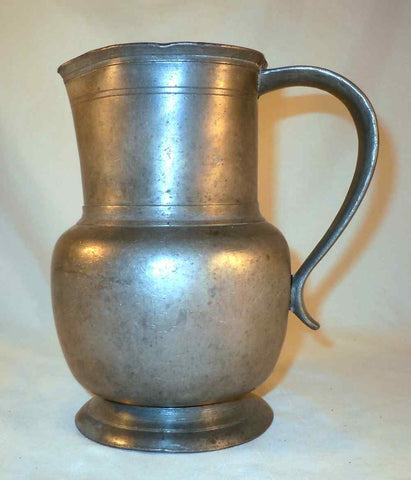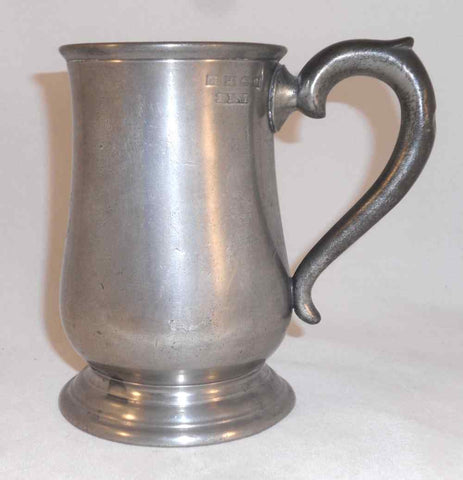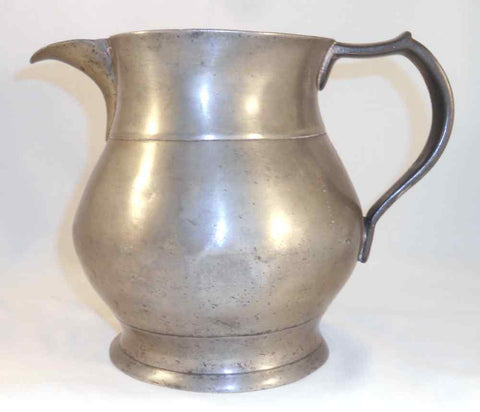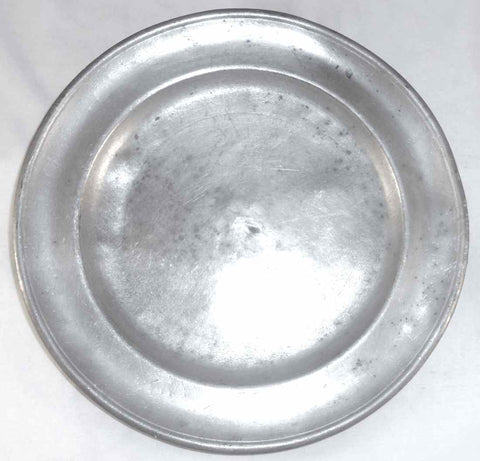Antique Pewter Deep Baptismal Basin Stephen Maxwell Glasgow Scotland Stamped RG
Description: An antique deep and rather heavy pewter basin or bowl having a flat rim narrow rim with an incised line. The bowl has a round flat base with rounded edge and rising sides. The sides of the bowl are slightly rounded and flared outwards rising to the flat rim. The bowl is marked in the center of the inside with a square mark having a sail ship in the center and the words "S. MAXWELL. MAY.Y.UNITED.STATES.OF.AMERICA" and what we believe are the letters "OU RISE" below the ship. We believe that the mark is meant to say "United States of America May You Rise" with the ship and the pewterer mark being the remainder of the square. It is said that Stephen Maxwell, who is Scottish from Glasgow, used this type of mark in the 1770 to stick it to the English since Scotland also wanted independence at the time. There is also the letters "RG" on the rim, which maybe the initials of the owner or the initials of the congregation that may have used the basin as a baptismal basin. The bowl, which we believe is form the 1770's is rather substantial and very well made. The bowl has a nice silvery look with extensive scratches, dings and pitting. Be that as it may, this is a great looking 250 years old pewter basin made in Glasgow Scotland. Please carefully review the photos presented as they are part and parcel of our description.
Date: Uncertain but Stephen Maxwell was active 1763 to 1795 and the mark referring to the United States of America puts in the 1770s during the War of the Independence in the US.
Origin: Was purchased at an estate auction in Southeastern Pennsylvania. The piece was made in Glasgow Scotland.
Size: The base measures ~10 1/8" in diameter at the top, is ~2 1/4" high and weighs a hefty ~2 1/2 Pounds.
Maker: Stephen Maxwell.
Marks: Marked in the center of the inside with a square mark having a sail ship in the center and the words "S. MAXWELL. MAY.Y.UNITED.STATES.OF.AMERICA" and what we believe are the letters "OU RISE" below the ship. We believe that the mark is meant to say "United States of America May You Rise" with the ship and the pewterer mark being the remainder of the square. It is said that Stephen Maxwell, who is Scottish from Glasgow, used this type of mark in the 1770 to stick it to the English since Scotland also wanted independence at the time.
Condition: The basin is in good condition. The piece is from early 18th century and is rather substantial and very well made. It is great looking and has a beautiful silvery look. The bowl is intact with no breaks or repairs. It has many scratches, multiple small and relatively shallow dings, and some pitting. Be that as it may, the piece is nice and would make a great addition to your collection of Antique Pewter. Please see photo for additional condition information.
Date: Uncertain but Stephen Maxwell was active 1763 to 1795 and the mark referring to the United States of America puts in the 1770s during the War of the Independence in the US.
Origin: Was purchased at an estate auction in Southeastern Pennsylvania. The piece was made in Glasgow Scotland.
Size: The base measures ~10 1/8" in diameter at the top, is ~2 1/4" high and weighs a hefty ~2 1/2 Pounds.
Maker: Stephen Maxwell.
Marks: Marked in the center of the inside with a square mark having a sail ship in the center and the words "S. MAXWELL. MAY.Y.UNITED.STATES.OF.AMERICA" and what we believe are the letters "OU RISE" below the ship. We believe that the mark is meant to say "United States of America May You Rise" with the ship and the pewterer mark being the remainder of the square. It is said that Stephen Maxwell, who is Scottish from Glasgow, used this type of mark in the 1770 to stick it to the English since Scotland also wanted independence at the time.
Condition: The basin is in good condition. The piece is from early 18th century and is rather substantial and very well made. It is great looking and has a beautiful silvery look. The bowl is intact with no breaks or repairs. It has many scratches, multiple small and relatively shallow dings, and some pitting. Be that as it may, the piece is nice and would make a great addition to your collection of Antique Pewter. Please see photo for additional condition information.












